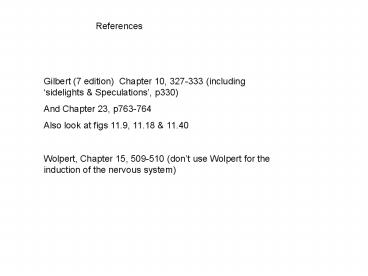References PowerPoint PPT Presentation
1 / 24
Title: References
1
References
Gilbert (7 edition) Chapter 10, 327-333
(including sidelights Speculations, p330) And
Chapter 23, p763-764 Also look at figs 11.9,
11.18 11.40 Wolpert, Chapter 15, 509-510
(dont use Wolpert for the induction of the
nervous system)
2
(No Transcript)
3
Rescue of dorsal structures by Noggin protein.
When Xenopus eggs are exposed to ultraviolet
radiation, cortical rotation fails to occur, and
the embryos lack dorsal structures (top). If such
an embryo is injected with noggin mRNA, it
develops dorsal structures in a dosage-related
fashion (top to bottom). If too much noggin
message is injected, the embryo produces dorsal
anterior tissue at the expense of ventral and
posterior tissue, becoming little more than a
head (bottom).
4
Ventralising signals
- Candidates are
- BMP4 (TGF-b family). Knock out BMP4 function,
get dorsalisation of mesoderm. - Xwnt8. Xwnt8 ventralises mesodermal explants
- The big surprise was that the signals from the
Organiser (Noggin, Frizbee etc.) interact with
the ventralsing signals - Noggin interact with BMP4 and prevent it binding
to its receptor - Frizbee interacts with Xwnt8 and prevents it
binding to its receptor
5
Xwnt8 is capable of ventralizing the mesoderm
and preventing anterior head formation in the
ectoderm. (A) Frzb is a protein secreted by the
anterior region of the organizer. It binds to
Xwnt8 before that inducer can bind to its
receptor. Frzb resembles the Wnt-binding domain
of the Wnt receptor (Frizzled protein), but is a
soluble molecule. (B) Xwnt8 is made throughout
the marginal zone.
6
(No Transcript)
7
Consequences of gastrulation
Wolpert, fig 4.1
8
(No Transcript)
9
Expression of Noggin mRNA
Figure 10.30 (Gilbert). Localization of the
noggin mRNA in the organizer tissue, shown by in
situ hybridization. (A) At gastrulation, noggin
message (dark areas) accumulates in the dorsal
marginal zone. (B) When cells involute, noggin
mRNA is seen in the dorsal blastopore lip. (C)
During convergent extension, noggin message is
expressed in the precursors of the notochord,
prechordal plate, and pharyngeal endoderm, which
extend (D) beneath the ectoderm in the center of
the embryo. (Photographs courtesy of R. M.
Harland.)
10
Consequences of gastrulation
Wolpert, fig 4.1
11
Generating twins (from Gilbert fig 10.10)
12
The neural ectoderm is induced during gastrulation
Wolpert, fig 4.19
13
Induction of the nervous system
- The nervous system is induced during
gastrulation - It is an ectodermal derivative
- Notochord and other Organiser derivatives come
to underlie the ectoderm during gastrulation - Twinned embryos from Organiser transplants
- Suggests that signals form the Organiser induce
neural tissue
14
Model for the action of the organiser
BMP4 (and other molecules) is a powerful
ventralising factor Organiser proteins such as
noggin chordin block BMP4 The effects of BMP4
and its antagonists can be seen in all 3 germ
layers BMP4 may elicit the activation of genes in
a concentration-dependent manner
15
Organisers
- All vertebrates have organisers
- Spemann Organiser - Xenopus
- Shield - Zebrafish
- Hensens Node - chick
- Node region - mouse
- All have a global organising function
- All can induce a secondary axis
16
Patterning of mesoderm and ectoderm in the
zebrafish is similar to Xenopus (ignore part c)
(A) Prior to gastrulation, the zebrafish
blastoderm is arranged with the presumptive
ectoderm near the animal pole, the presumptive
mesoderm beneath it, and the presumptive endoderm
sitting atop the yolk cell. The yolk syncitial
layer(and possibly the endoderm) sends two
signals to the presumptive mesoderm. One signal
(lighter arrows) induces the mesoderm, while a
second signal (heavy arrow) specifically induces
an area of mesoderm to become the dorsal mesoderm
(embryonic shield). (B) Formation of the
dorsal-ventral axis. During gastrulation, the
ventral mesoderm secretes BMP2B (arrows) to
induce the ventral and lateral mesodermal and
epidermal differentiation. The dorsal mesoderm
secretes factors (such as Chordino) that block
BMP2B and dorsalize the mesoderm and ectoderm
(converting the latter into neural tissue).
17
B-catenin in Xenopus (large) and zebrafish (small)
B-catenin is seen in the yolk syncitial layer
nuclei beneath the future embryonic shield
18
Chordin is required in zebrafish for neural
ectoderm induction
19
In the mouse, lim mutants show a reduction in
anterior neural structures. Lim is a
transcription factor required for activation of
noggin, chordin and other secreted proteins of
the node
20
Homology and conservation
- All vertebtrates have signaling centres, like
the Spemann Organiser - The signals that induce and pattern the mesoderm
are conserved - In each class of vertebrates, neural ectoderm is
permitted to form where the BMP-mediated
induction of epidermal tissue is prevented
21
The signals that induce the nervous system are
conserved in Drosophila and vertebrates
BMP4 dpp (decapentaplegic) Chordin sog (short
gastrulation Chordin and sog can substitute for
each other
The dorsal neural tube of vertebrates and the
ventral nerve cord of Drosophila are specified by
the same set of instructions, conserved through
evolution
22
Injection of sog into a Zenopus embryo causes
ventralisation
Rescue of dorsal structures by noggin
Short gastrulation
23
The body plans of vertebrates and arthropods are
inverted with respect to each other. Vertebrates
have a dorsal nervous system arthropods have a
ventral nervous system
24
The three main stages of vertebrate development
- 1) setting up the main body axes (A/P and D/V)
- 2) specification of three germ layers (endoderm,
mesoderm and ectoderm) - 3) germ layer patterning (mesoderm and early
nervous system) - Maternal genes provide factor (RNA and proteins)
to the egg during oogenesis (including
sub-cellular localization to specific regions. - Zygotic genes are expressed by the embryo's
genes. - Both maternal and zygotic genes may have long
term effects upon the embryo's development.

